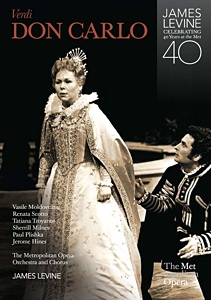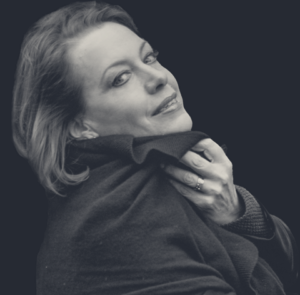A quintessential theater man as well as a brilliant conductor, James Levine rightfully chose not only the five-act version of Don Carlo for this 1980 performance but begins the opera as Verdi had originally conceived it.
The Woodcutters chorus and the episode in which Elisabetta gives her necklace to a destitute woman are pages essential to the structure of the whole opera: they articulate around that plangent acciaccatura which, as a micro-Leitmotiv snaking through the entire course of the opera, will drill into Filippo’s aria. The effect is greater at that later point if the numerous times it has played—especially at the very beginning—has been indelibly impressed into our minds, allowing us to recognize it in each of its appearances.
The Met edition is thus quite long, and if sometimes it appears to be dragging, it is because of the ineptitude of one crucial member of the cast. Levine does all he can to keep it alive and animated with his superlative conducting, which can be described as dynamic, rich with intense and full-bodied sounds, jagged in its rhythms and colors. The conductor seems more concerned with creating intense theatricality than a mere “beautiful” sound. In his conception, an extremely contrasted dramatic power polarized on each single character clearly prevails on lyric abandon.
The DVD under review (part of James Levine: Celebrating 40 Years at the Met – DVD Box Set) immortalizes the first revival of John Dexter’s 1979 production, which is heading for the shelf this coming season after over 30 years of service. His mise-en-scène is as simple as it can be. Completely absent are the blunders and the painful lapses of taste so dear to the irremediably kitsch esthetics of a Zeffirelli or a Von Karajan (in his directorial attempts), substituted by a moderate opulence in the mass scenes, as well as very traditional movements reserved to each single character, to whom the widest gestural and mimic freedom is allowed.
The cast exploits this freedom to the best—or worst—of their individual abilities.
Sherrill Milnes is musical and has praiseworthy intentions, a pleasant timbre, as well as a broad range of colors. On the negative side, the baritone never resolved the problem of a correct production around the register change, and the consequences are open, hard and often flat passaggio notes. When he sings piano, “a fior di labbro”, (and Posa is very frequently required to do so), Milnes doesn’t always find the right support, and the result is an opaque sound that “goes back into the throat”.
The Grand Inquisitor was one of Jerome Hines’ signature roles; in 1950, he had sung it in the legendary production that inaugurated Rudolf Bing’s reign. Thirty years have taken their inevitable toll on his voice, but also refined his interpretation.
Paul Plishka (Filippo II) has been around for such a long time that it is difficult to imagine that at one point he was young, too. In this performance he was only 39 years old, but his voice already presents clear signs of dryness and wear. He does not seem to have particular insights to this formidable role, which is presented as a generic tyrant.
The Oscar for lack of personality however should be assigned to Vasile Moldoveanu, the protagonist. The Romanian tenor maintains a single vocal color and an unvaried facial expression (a light frowning) throughout the opera, no matter what happens to the character he is supposedly impersonating. This is unfortunate, because the role of Don Carlo, a bundle of neurotic sensitivity, demands—especially in the five-act version—an immense range of emotions. It is a thinking tenor role. Moldoveanu rushes through his music and seems to have no clue as to what he is singing. And the singing is not so great to begin with: forced high notes abound, and the basic timbre is undistinguished and impersonal.
The ladies simply annihilate their male colleagues. Tatiana Troyanos is superb. The voice is warm, rich, vibrant. Her Eboli is elegant, impetuous and passionate. She translates the wide range of her inspired fraseggio into a singing splendid for its beauty , luminosity and its solid emission. In the Veil Song she negotiates the Moresque ornaments with an almost ridiculous dexterity, with heavenly ascents to the high register. She throws herself into “O don fatale” with impetus—too much perhaps, as she runs a bit out of steam at the very end, when she is forced to take two anticlimactic breaths, one right before and one immediately after the B flat on the word “salverò”, thus somewhat spoiling the effect.
Renata Scotto is in my opinion the Elisabetta who most closely adheres to the true nature of this great but elusive character. Her round, compact and incisive timbre spontaneously suggest the character of a young woman with vibrant communicativeness, and she does not strain for the magniloquent accents of a supposed regality (a myth pursued by lesser interpreters of this role, and an aspect thoroughly secondary, if not deleterious), but those of a true humanity.
This is the essential contrast of the opera: gigantic surroundings where humanity is crushed under the weight of opportunism, ambition, or blind political necessity, which imprison a young but hardly inexperienced woman. Elisabetta does not belong to that world, but knows it very well; she accepts her destiny with an austere and almost demure melancholy, refusing to sacrifice her human richness. She may appear to be a victim, but never an unaware victim; on the contrary, she is always perfectly conscious of what is happening to and around her, and why.
The clash between Scotto’s terse, vibrant, extraordinarily expressive singing with the subtle but stunning “cupio dissolvi” of Levine’s orchestra on the one hand develops the character conferring it an authentic and palpitating tragic stature, on the other hand forms a formidably effective narrative contrast.
Even when an artist has the right ideas, he or she can give full life to a character only when the intentions or intuitions are backed by a good technique; Scotto, still in good vocal shape, is an adroit technician, an adept in the art of legato and tasteful portamentos. The role of Elisabetta calls for a very strong middle register, which is where at this point in her career Scotto’s strength lies, enabling her to concentrate on the realization of a tremendous, ingenious characterization.
A video of the 1983 revival of this same staging has long been commercially available. Levine is still the conductor, but the cast is completely different. Louis Quilico is barely acceptable as Posa. Ferruccio Furlanetto sounds obviously fresher than Jerome Hines. Preferring Mirella Freni and Grace Bumbry to Scotto and Troyanos is a pure matter of taste, as each of these four ladies is excellent in her own way. Placido Domingo and Nicolai Ghiaurov, on the other hand, are vast improvements over their 1980 counterparts.
Any true opera lover should own both.







Comments